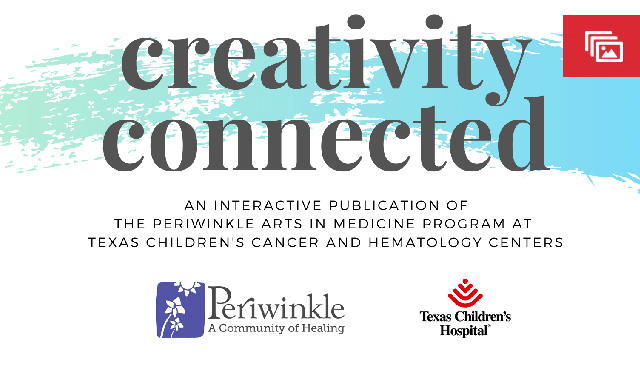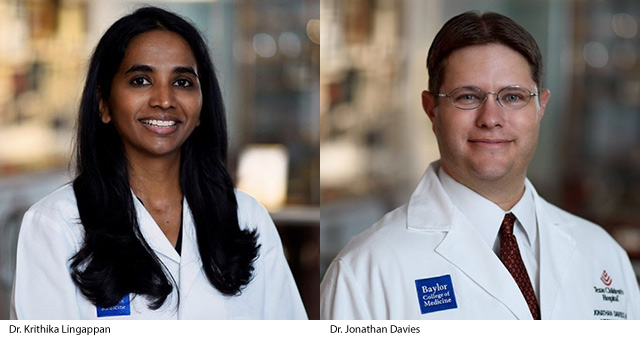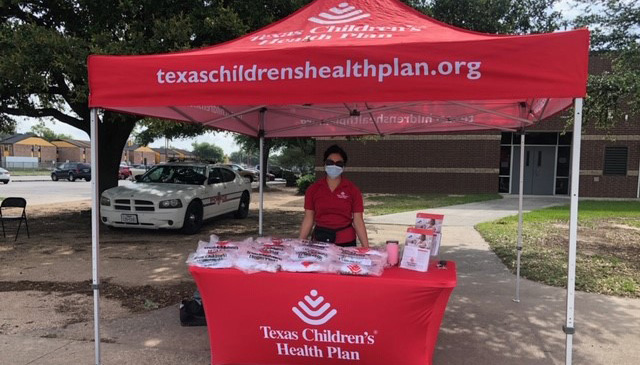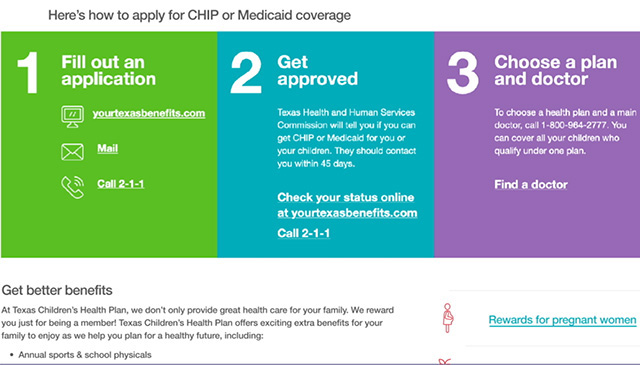
As Texas Children’s begins accepting adult patients, Chief Nursing Officer Mary Jo Andre shares what this new opportunity means for nursing and how our nurses can do their part to help curb the spread of COVID-1. Read more

As Texas Children’s begins accepting adult patients, Chief Nursing Officer Mary Jo Andre shares what this new opportunity means for nursing and how our nurses can do their part to help curb the spread of COVID-1. Read more

For many patients and their families, coping with a new illness can be challenging, and often times, can produce anxiety and fear. Since 1997 the Periwinkle Arts in Medicine Program at Texas Children’s Cancer and Hematology Centers, has helped numerous patients cope with their illness through various art opportunities.
“Access to the arts is essential to our every day well-being, especially in the most challenging of times,” said Carol Herron, coordinator for the Periwinkle Arts in Medicine Program. “It gives our patients affected by cancer and blood disorders the opportunity for self-expression, empowerment and healing through the arts.”
Before the COVID-19 pandemic, the program’s community Art Partners frequently visited the Cancer and Hematology Clinic to engage patients and their siblings in fun and educational arts activities. Since the art partners are unable to come into the clinic due to COVID-19 restrictions, the Periwinkle Arts in Medicine Program launched a creative and interactive way to virtually connect with patients and their families.
Creativity Connected is a weekly interactive virtual arts newsletter that the Periwinkle Arts in Medicine program rolled out in response to the COVID-19 pandemic. The newsletter goes out weekly to a database of more than 1,300 Texas Children’s Cancer and Hematology Centers’ patients and their siblings.
The publication provides a collection of enjoyable arts activities for children including video clips on how to build a spaghetti hedgehog or how to make musical instruments using common household materials. Creativity Connected also features a selection of artwork from Making A Mark®, an exhibition of art and creative writing from children touched by cancer and blood disorders at our Cancer and Hematology Centers.
One of the long-time Art Partners that is part of the Periwinkle Arts in Medicine Program is Purple Songs Can Fly, which has provided hundreds of patients and siblings a musical outlet to share their incredible stories and songs of hope which are produced in an in-house studio at Texas Children’s Cancer Center.
Below is a note from a child who wrote a song virtually with Purple Songs Can Fly founder and executive director Anita Kruse, and then had that song shared in the Creativity Connected newsletter.
“I feel happy to make songs with Anita. She is so kind. My sister and I enjoy making and singing songs. I like the way she plays the piano. When I grow up I would love to play piano like her.”
In addition to Purple Songs Can Fly, several other Art Partners that have contributed to bringing art therapy to our cancer and hematology patients include Writers in The Schools, Houston Center for Photography, Young Audiences of Houston, the Houston Symphony, The Woodlands Children’s Museum, the Museum of Fine Arts Houston, River Oaks Chamber Orchestra and DaCamera.
Texas Children’s partners with The Periwinkle Foundation, an organization that develops and provides programs that positively change the lives of children, young adults and families who are challenged by cancer and other life-threatening illnesses and are cared for at Texas Children’s Hospital.
Since the pandemic began, fewer children than usual have visited emergency rooms. But, according to media reports, doctors across the country say they have seen a growing number of children who suffered broken bones on bikes and trampolines, accidental poisonings and other severe injuries during the widespread lockdowns.
Instead of getting injured on playgrounds or during team sports, many children are getting hurt while playing with outdoor toys and sports equipment at home. Sales of trampolines, scooters, skateboards, bicycles and inflatable pools have surged as families look for ways to keep their kids entertained — and with parents often unable to provide constant supervision because of work and other obligations, injuries have followed.
The story is no different at Texas Children’s. All three of our trauma centers have seen an increase in the number of patients seeking our care.
“It’s been really busy for sure,” said Dr. Bindi Naik-Mathuria, medical director of the Trauma Center at Texas Children’s Hospital Medical Center Campus. “We’re seeing everything from dog bites and falls to car accidents, drownings, gunshot wounds, child abuse and neglect. The effects of the pandemic and subsequent lockdowns are definitely taking a toll on families in the Greater Houston area and beyond.”
But, Naik-Mathuria said, Texas Children’s is here for those who need our care and the trauma teams at all three campuses are well equipped to handle whatever situation they encounter.
When a child comes to one of our hospitals with a traumatic injury, they are cared for by members of one of our trauma teams either at the Medical Center Campus, at Texas Children’s Hospital The Woodlands or at Texas Children’s Hospital West Campus.
The trauma centers at The Woodlands and West Campus were recently designated Level IV trauma centers by the Department of State Health Services. The trauma center at the Medical Center Campus is a Level I Trauma Center and has been designated as such since 2010.
The teams at these centers are responsible for a patient’s care throughout their journey at Texas Children’s, which can sometimes be months long. During this time, team members work with departments across the system to coordinate a patient’s care.
“The integration across our system is so important,” said Tarra Kerr, director of the trauma program at all three campuses. “We all work together to make sure our patients get the right treatment so they can return home and have the best possible outcome.”
At the Medical Center Campus, the Level I pediatric trauma center provides around-the-clock coverage to evaluate and treat the most severely injured pediatric patients. Averaging over 1,000 trauma admissions per year, teamwork is crucial in the rapid and decisive actions needed to treat traumatic injuries.
Dedicated space for trauma cases is available in the Emergency Center, our main operating room suite and inpatient units. Approximately 70 percent of all trauma cases come from within the Metro Houston area, which consists of nine counties covering more than 9,500 square miles.
Over 50 percent of the trauma patients cared for at the Medical Center Campus are transferred from other hospitals. The average time to accept a transfer is 15 minutes, well below the 30 minute threshold that is allowed by federal regulation.
The Level IV trauma centers at West Campus and in The Woodlands are capable of stabilizing any trauma patient received, handling onsite single-system orthopedic injuries and superficial lacerations. More complex cases are stabilized and then transferred to a higher level trauma center such as our Level I trauma center in the Medical Center.
The Level IV designation sends a clear signal to first responders that our community hospitals are equipped to handle such trauma patients. West Campus and The Woodlands have been caring for such patients since the hospitals opened their doors, however the designation formalizes that process and holds the centers to certain quality and process improvement standards.
“We are a solid, tri-campus trauma center,” Kerr said. “We have made a lot of progress over the years that better ensures patients receive the right care at the right place at the right time.”
Another area of focus for Texas Children’s trauma centers is injury prevention and research. Kristen Beckworth manages this aspect of the trauma centers at all three campuses. Her team of six educators works in the hospitals and the communities that surround them.
“The goal of the Center for Childhood Injury Prevention is to address major areas of unintentional injuries to children in our local area,” Beckworth said. “This is accomplished by raising awareness among adults and children, providing lifesaving education and resources, and by making childhood injury a public priority.”
With pediatric injury being the No. 1 cause of injury and death of children in the United States, the center educates thousands of parents and children each year on a variety of child safety topics, such as child passenger safety, safe sleep, home safety and bike and pedestrian safety. The center works with trauma center registrars to determine trends, write grants, and implement programming so that what they do is evidence based and in line with what the community needs.
Valuable local partners are key to the center’s success, especially during the pandemic when Beckworth and her team are tied to their decks more than giving in-person education and working with people face to face.
“It’s been challenging, but we are doing what we can,” Beckworth said. “People have been very appreciative of our continued commitment to our program during such trying times.”
Some things Beckworth and her team have done since the pandemic is offered virtual car seat checks, partnered with Houston Apartment Association and Home Owner’s Association to distribute water safety tip sheets, and reached out to all Texas Children’s Pediatrics practices and Texas Children’s Urgent Cares to inform them about the increase in traumatic injuries and tips on how to prevent them.
In addition to injury prevention, Texas Children’s trauma centers aims to continuously evaluate and improve the quality of care given to trauma patients from the perspective of our patients, parents, providers and system. Our trauma process improvement program monitors and evaluates patient care and system performance, while ensuring implementation of a culture of safety. The team participates in the American College of Surgeons’ Trauma Quality Improvement Program and attends the annual scientific meeting and training which compares and provides benchmarking for all level I and II trauma centers.
“We have a very active research program and put a lot of protocols into place that increase the quality of care for our patients, many of whom are forever changed by their injuries and have a strong bond with the people who helped them through one of the toughest times in their lives,” Naik-Mathuria said. “I am very proud of what we and everyone involved has accomplished for the betterment of our patients and their families.”
For more information about Texas Children’s trauma centers and the teams that support them, click here. For more information about the Center for Childhood Injury and Prevention, click here.

The rapid spread of COVID-19 has resulted in more than 4 million cases worldwide. The disease has a marked preference for adults with children being relatively spared. Understanding this preference might hold the key to the identification of therapeutic targets and is the topic of a paper Texas Children’s, Baylor College of Medicine, University of Texas Health Science Center and University of Texas McGovern Medical School physicians recently published in The American Journal of Physiology-Lung Cellular and Molecular Physiology.
The paper suggests differences in lung physiology and immune function as possible reasons why children are often spared from severe illness associated with SARS-CoV-2, the novel coronavirus that causes COVID-19.
The number of children under the age of 18 infected with SARS-CoV-2 has been found to be considerably lower than adults. Early reports from China and Italy have shown that children who become infected with the virus show symptoms less often than adults and even when they are symptomatic, are less likely to develop respiratory symptoms such as a cough or shortness of breath. In most cases, the infected under-18 population does not become as severely ill as their older counterparts. The newly identified multisystem inflammatory syndrome in children (MIS-C) associated with COVID-19, though serious, affects only about 1 percent of young people exposed to SARS-CoV-2.
“These profoundly decreased rates of symptomatic infection, hospitalization and death are well beyond statistical significance, require further examination and may hold the key to identifying therapeutic agents,” said the paper’s lead author, Texas Children’s Neonatologist Dr. Krithika Lingappan.
The way the SARS-CoV-2 virus enters the body and the state of the immune system itself are thought to be two primary differences in how children and adults become infected with the novel coronarvirus.
SARS-CoV-2 enters the body by binding to angiotensin converting enzyme-2 (ACE2), an enzyme that is attached to the outer surface of cells in the lungs, arteries, heart and other organs. This interaction is analogous to the virus unlocking the door to a cell. The higher the expression of ACE2 in the body, the more likely the virus will get in.
Studies have found that expression of ACE2 in the lungs increases with age. Infants and very young children have very low ACE2 expression, and older children still have lower expression than adults. Research suggests that children may be protected from the serious respiratory components of COVID-19 — including acute respiratory distress syndrome — due to their reduced ACE2 expression.
The immune system also plays a role in the novel coronavirus infection. Heightened immune response is often a factor in the inflammatory “cytokine storm” phase of COVID-19, in which the body attacks itself. Studies have found that CD4+ fighter cells in the immune system play an important role in limiting replication of the virus and that adults with moderate-to-severe COVID-19 had lower levels of CD4+ and CD8+ cells. Lung tissue in children naturally has a higher concentration of regulator T-cells, which may protect against severe COVID-19 by suppressing the immune response that, in adults, may lead to a cytokine storm.
“Selective, age-associated mortality render[s] COVID-19 a unique, infectious disease,” said Texas Children’s Neonatologist and Dr. Jonathan Davies, another author of the paper. “Insights into age-related variability in pathophysiological processes may offer critical observations, revealing focused paths of therapeutic investigation.”
Davies and Lingappan both said multidisciplinary collaboration between physicians and scientists, engaged in both pediatric and adult pursuits, holds significant promise and should be encouraged.
Click here to read the full article, “Understanding the age divide in COVID-19: Why are children overwhelmingly spared?”
Authors of the paper are:
Dr. Krithika Lingappan, Texas Children’s and Baylor College of Medicine
Dr. Harry Karimouty-Quintana, University of Texas Health Science Center
Dr. Jonathan Davies, Texas Children’s and Baylor College of Medicine
Dr. Bindu Akkanti, University of Texas Health Science Center
Dr. Matthew Harting, University of Texas Health Science Center

Amid a new world order that demands social distancing, Texas Children’s Health Plan has come up with creative ways to meet the needs of the community.
The health plan has now joined forces with Aldine ISD to host community drive-through events, thanks to the leadership of Jermaine Monroe, vice president for Human Resources. Monroe spearheaded a partnership between the health plan and the district last year, which is now paying off in a new way.
Twice each week, families are able to pick up meals for their children at the district’s high schools, while also receiving information on our insurance program.
Isela Garcia, community marketing specialist who works with the district on the weekly events, says that families are grateful. “It is an incredibly safe way to meet several goals,” said Garcia. “Families can pick up student meals and receive information about application assistance and other services.”
In addition to our partnership with Aldine ISD, the health plan has also partnered with Harris County Precinct 2 Commissioner Adrian Garcia. Precinct 2 has the highest number of uninsured children in the county.
In an effort to help local small businesses, every Friday for the last few months Commissioner Garcia tasked his team to partner with several area restaurants to provide drive-through “Hot Meal Fridays” at several community centers. This is just one of many programs Commissioner Garcia initiated as part of Precinct’s COVID 19 response efforts. “Hot Meals Fridays” provide a nutritious meal for the entire family by serving everyone in the vehicle. With the involvement of Texas Children’s Health Plan these families also receive much needed health insurance information.
“As commissioner for one of the most medically underserved areas in Harris County, I made improving our public health care system and improving access for those in my precinct a major priority, and this partnership is critical to making those improvements happen. This partnership with a premier partner like the Texas Children’s Health Plan helps in ensuring that no one is left behind – especially our children. I’m grateful to the health plan team for stepping up for our community during this difficult time,” Commissioner Garcia said. “The health plan understands the importance of feeding children and families while also providing for their health care needs.”
“The needs of our target population are significant — now, more than ever — and we are blessed that we’ve been able to continue meeting these needs, while maintaining social distancing so that everyone can stay safe,” said Claudia Garcia, marketing manager for the health plan.
However, the events are just the first step. Garcia says that assisting new members with their applications once they reach out is just as important; and her team is completing this process with flying colors. Just recently, 49 applications were completed within one week.
If you know of anyone who may want more information about Texas Children’s Health Plan or may need assistance with their application, visit texaschildrenshealthplan.org.

The latest marketing campaign launched by Texas Children’s Health Plan speaks to those who have just lost their jobs. The goal is to share the good news of what our programs can provide to children and families.
“Unfortunately, the coronavirus pandemic has affected our economy and therefore our job market,” said Denise Jimenez, marketing manager at Texas Children’s Health Plan. “This means that there are thousands of people in our service area who are out of work and out of benefits. If they don’t know about our health plan, we want to change that because we can help.”
Texas Children’s Health Plan is an insurance plan much like Blue Cross Blue Shield, United Healthcare, Cigna or many others. The difference is that it manages the health care of low-income children and pregnant women who receive government-funded insurance, such as Medicaid. The purpose of Texas Children’s Health Plan is to deliver the best health care possible for its members.
If you know anyone who has recently lost his or her job and is in need of health care benefits, share the texaschildrenshealthplan.org link.
Want to see the new commercial? Here it is.

Candles flicker
The following passage was written by Texas Children’s Chaplain Jessica Shannon.
When we look at a candle, it often calms us. Perhaps that’s why people like to give scented candles as gifts when a friend has experienced pain, stress, and needs permission to take a deep breath. It seems as though the person receiving the candle has a light that is struggling to stay lit. Many religions use candles at times of reflection as well. There is hope and peace when we see the strong light of a candle.
The things we see in our daily lives and in our healthcare jobs are heavy enough to emotionally, physically, and spiritually exhaust anyone. And that was pre-COVID. When we are drained and running on fumes, we struggle to find joy. We struggle to see our self-worth. We are hurt by others’ comments. We have a dark cloud above us that is covering our beautiful lights and it can be really difficult to push that dark cloud away. Our lights can’t shine.
Families, particularly mothers of admitted patients, often tell us they “need to be strong.” They think that ignoring the dark cloud is a good way to cope. Through validation and guidance, my hope is to help them see that strength is truly found in asking for help. Strength is allowing yourself to cry and seeking support. Asking for help allows the cloud to slowly drift away to allow hope to creep back into our lives. We help their flickering candle shine brighter.
There is a battery-operated candle on my desk at Texas Children’s Hospital The Woodlands that is lit (well, turned on) each time a child we cared for dies, whether they passed within our walls, at another Texas Children’s facility, or at home on hospice. It is my personal reminder to remember the child and their family as we have to move onto the next patient. We move forward immediately because the culture of healthcare does not give us a moment to pause. Each time the candle catches my eye while charting or darting off to a patient floor, I remember. We need to remember. We need to pause. We need to see the hope in asking for help when we don’t have the strength to keep going.
There is no dark cloud over that plastic candle on my desk. It is a candle that symbolizes loss but also hope. It is a way for a Chaplain to pause and remember a family and to remember that we all are human. Let’s be human together, friends. When we feel a dark cloud is weighing so heavily on us that hope is hard to see, reach out to a friend. When you see someone’s light is darkening, find a way to help relight their candle. There is always light in the darkness.